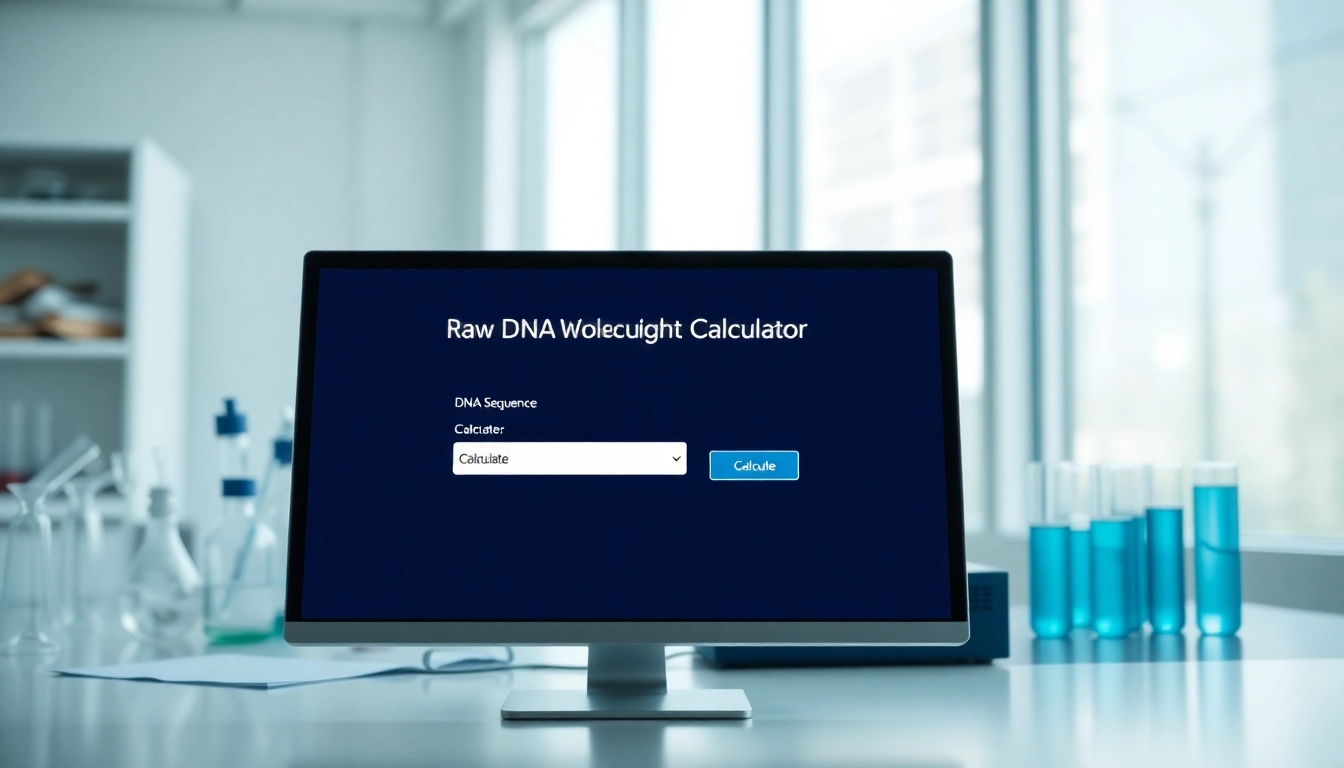Understanding the DNA Molecular Weight Calculator
What is the DNA Molecular Weight Calculator?
The DNA Molecular Weight Calculator is a sophisticated tool designed to compute the molecular weight of a given DNA sequence. By analyzing the nucleotide composition, this calculator provides researchers with crucial data regarding the mass of oligonucleotides, plasmids, and other DNA fragments. The molecular weight is expressed in grams per mole (g/mol), representing how much one mole of DNA weighs based on its base pairs. This tool is particularly useful for molecular biology applications, including PCR, cloning, and sequencing, where precise measurements are essential for successful experimental design.
Importance of Calculating DNA Molecular Weight
Determining the molecular weight of DNA is vital for several reasons. Firstly, it helps calculate the concentration of DNA when preparing solutions for laboratory experiments. For instance, knowing the molecular weight allows scientists to convert mass (in micrograms) to molarity (in micromoles per liter), which is crucial for creating precise solutions for enzymatic reactions. Furthermore, accurate molecular weight calculations are essential when designing primers for PCR, as they influence binding efficiency and specificity.
Moreover, the DNA Molecular Weight Calculator aids in determining the number of molecules in a given amount of DNA. This information is essential for evaluating how much DNA to use for various applications, ensuring efficient resource allocation in experiments. For these reasons, researchers and students alike rely on tools like the DNA Molecular Weight Calculator as an essential part of their toolkit.
How the Calculator Works
The DNA Molecular Weight Calculator operates using fundamental biochemical principles. The molecular weight of a nucleotide is determined by the total mass of its constituent elements: carbon, hydrogen, nitrogen, oxygen, and phosphorus. Each nucleotide, the building block of DNA, has a specific molecular weight, and the calculator aggregates these values according to the provided sequence.
When a user inputs a DNA sequence, the calculator analyzes the sequence to identify the number of each nucleotide (adenine, thymine, cytosine, and guanine), multiplies these counts by their respective molecular weights, and sums the results to arrive at the total molecular weight. This process ensures that the final calculation reflects the precise nature of the input sequence.
Steps to Calculate DNA Molecular Weight
Inputting Your DNA Sequence
The first step in using a DNA Molecular Weight Calculator is inputting the DNA sequence. Most calculators accept sequences in various formats, including raw sequences, FASTA format, or list formats. Ensure that the sequence is free of any spaces or extraneous characters that could lead to inaccuracies. It is often beneficial to validate the sequence with tools provided by bioinformatics platforms to confirm its integrity before proceeding.
Selecting Calculation Parameters
After inputting the sequence, users may need to select specific parameters, though most calculators are designed for general use and automatically provide the necessary defaults. For example, users may have the option to indicate whether the DNA is single-stranded (ssDNA) or double-stranded (dsDNA), as this can affect molecular weight calculations. Additionally, some advanced calculators might allow for variations such as the presence of modifications in nucleotides. Having clarity on these parameters ensures that the output is as accurate and relevant as possible for the intended application.
Interpreting the Results
Following the calculations, the results typically include several key pieces of information: the molecular weight in g/mol, the total nucleotide count, and sometimes the concentration if that data can be inferred. Understanding these results is crucial for applying them effectively in experimental setups. For example, if the molecular weight is calculated to be 660 g/mol, this means one mole of the DNA strand weighs 660 grams, providing valuable insight when determining concentrations for technical procedures in the lab.
Common Scenarios for Using the DNA Molecular Weight Calculator
Research Applications
In research, the DNA Molecular Weight Calculator finds extensive use. One of the primary applications is in the preparation of samples for PCR. Accurate calculations determine the required amounts of template DNA, ensuring optimal reaction conditions. Additionally, in cloning experiments, precise molecular weight assessments inform the necessary insert and vector ratios, which is pivotal for successful ligation. Researchers also utilize these calculations for genome assembly projects, where the sheer volume of sequences demands precise molecular weight information to avoid discrepancies in the assembly process.
Clinical Uses
In clinical settings, understanding DNA molecular weight plays a significant role in diagnostics and therapeutic applications. For instance, molecular weight calculations are crucial when designing assays for detecting genetic mutations or pathogens, where the amplification of specific DNA segments can be influenced by the molecular weight of involved sequences. Additionally, biotechnology and pharmaceutical companies leverage these calculations to standardize DNA preparations used in gene therapy treatments, ensuring safe and effective doses.
Educational Purposes
Within educational environments, the DNA Molecular Weight Calculator serves as an essential learning tool. It helps students grasp fundamental concepts in molecular biology pertaining to nucleic acids. By engaging with the calculator, students can understand the practical implications of molecular weight calculations, thereby reinforcing theoretical lessons in a hands-on manner. Moreover, incorporating this tool into laboratory courses can enhance students’ practical skills in nucleic acid analysis.
Best Practices for Using the DNA Molecular Weight Calculator
Accurate Sequence Formatting
Formatting DNA sequences correctly is crucial for accurate calculations. Users should ensure that sequences are devoid of extra characters or line breaks. Even minor errors in input can lead to significant mistakes in the output. Always verify the sequence through trusted bioinformatics databases or software. Standardizing to uppercase letters for nucleotide symbols (A, T, C, G) is also a common practice that aligns with many calculators’ requirements.
Understanding Units and Conversions
Having a solid understanding of the units involved in molecular weight is vital. Familiarizing oneself with grams (g), moles (mol), and concentration units (μg/μL, pmol, etc.) can significantly enhance one’s ability to translate molecular weight results into practical applications. Additionally, clear awareness of conversion factors is beneficial when dealing with concentrations—knowing how to switch between weight and molarity can streamline laboratory workflows and experiment preparations.
Common Errors to Avoid
Several common pitfalls can compromise results. Users should be cautious of inputting invalid characters or formatting errors, as mentioned previously. Failing to select the correct nucleotide type (ssDNA vs. dsDNA) can lead to substantial differences in calculated molecular weight. It is also essential to re-check the calculated molecular weight against expected values based on known sequence data to identify potential discrepancies early in the experimental process.
Advanced Features of DNA Molecular Weight Calculators
Additional Calculations and Tools
Many modern DNA Molecular Weight Calculators integrate additional features and tools that can significantly enhance their utility. These may include options for calculating molarity, concentration conversions, and even features for estimating the melting temperature (Tm) of DNA sequences. By incorporating these complementary calculations, users can obtain a fuller picture of their DNA sample’s behavior in different experimental conditions, facilitating more informed decision-making.
Comparative Analysis Features
Some calculators have advanced comparative analysis functions, allowing users to input multiple sequences and compare their molecular weights side-by-side. This feature is particularly beneficial in situations involving multiple samples, such as comparing various plasmids or analyzing different gene constructs. It enables researchers to make quick and informed decisions regarding which constructs are most suitable for specific applications based on their molecular weight profile.
User Customization Options
User customization options are increasingly available in some advanced calculators, enabling users to tailor the calculation parameters to fit specific experimental protocols. This could involve modifying the parameters used for calculating molecular weights based on unique sample conditions or including additional nucleotide modifications that may impact results. Customization can enhance user experience and ensure that the tool aligns closely with individual research needs.



